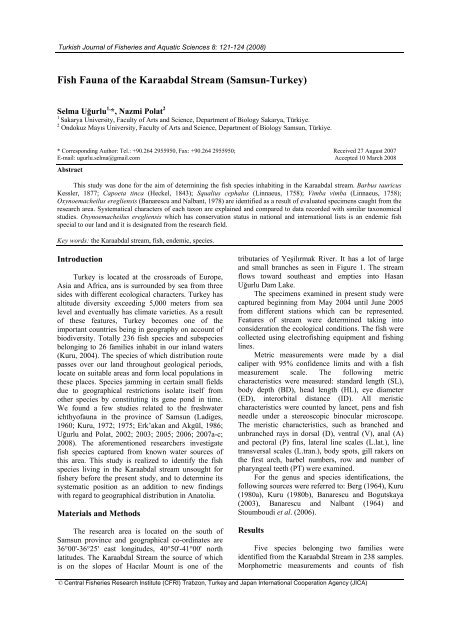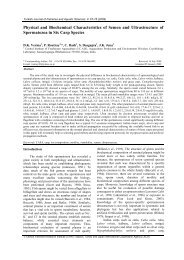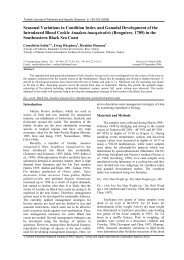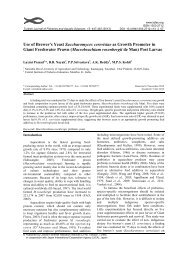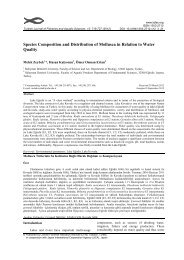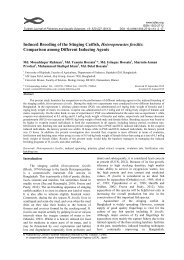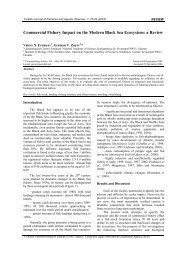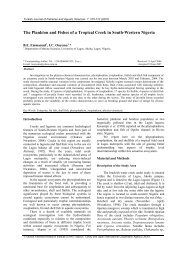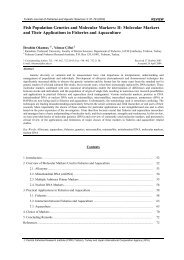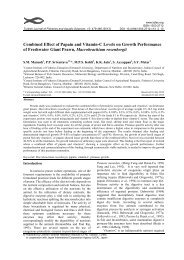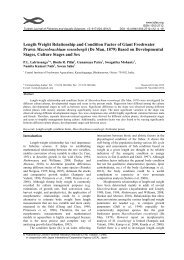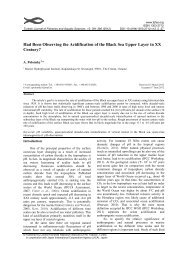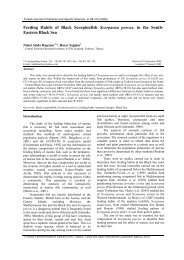Fish Fauna of the Karaabdal Stream (Samsun-Turkey)
Fish Fauna of the Karaabdal Stream (Samsun-Turkey)
Fish Fauna of the Karaabdal Stream (Samsun-Turkey)
You also want an ePaper? Increase the reach of your titles
YUMPU automatically turns print PDFs into web optimized ePapers that Google loves.
Turkish Journal <strong>of</strong> <strong>Fish</strong>eries and Aquatic Sciences 8: 121-124 (2008)<strong>Fish</strong> <strong>Fauna</strong> <strong>of</strong> <strong>the</strong> <strong>Karaabdal</strong> <strong>Stream</strong> (<strong>Samsun</strong>-<strong>Turkey</strong>)Selma Uğurlu 1, *, Nazmi Polat 21Sakarya University, Faculty <strong>of</strong> Arts and Science, Department <strong>of</strong> Biology Sakarya, Türkiye.2 Ondokuz Mayıs University, Faculty <strong>of</strong> Arts and Science, Department <strong>of</strong> Biology <strong>Samsun</strong>, Türkiye.* Corresponding Author: Tel.: +90.264 2955950, Fax: +90.264 2955950;E-mail: ugurlu.selma@gmail.comAbstractReceived 27 August 2007Accepted 10 March 2008This study was done for <strong>the</strong> aim <strong>of</strong> determining <strong>the</strong> fish species inhabiting in <strong>the</strong> <strong>Karaabdal</strong> stream. Barbus tauricusKessler, 1877; Capoeta tinca (Heckel, 1843); Squalius cephalus (Linnaeus, 1758); Vimba vimba (Linnaeus, 1758);Oxynoemacheilus eregliensis (Banarescu and Nalbant, 1978) are identified as a result <strong>of</strong> evaluated specimens caught from <strong>the</strong>research area. Systematical characters <strong>of</strong> each taxon are explained and compared to data recorded with similar taxonomicalstudies. Oxynoemacheilus eregliensis which has conservation status in national and international lists is an endemic fishspecial to our land and it is designated from <strong>the</strong> research field.Key words: <strong>the</strong> <strong>Karaabdal</strong> stream, fish, endemic, species.Introduction<strong>Turkey</strong> is located at <strong>the</strong> crossroads <strong>of</strong> Europe,Asia and Africa, ans is surrounded by sea from threesides with different ecological characters. <strong>Turkey</strong> hasaltitude diversity exceeding 5,000 meters from sealevel and eventually has climate varieties. As a result<strong>of</strong> <strong>the</strong>se features, <strong>Turkey</strong> becomes one <strong>of</strong> <strong>the</strong>important countries being in geography on account <strong>of</strong>biodiversity. Totally 236 fish species and subspeciesbelonging to 26 families inhabit in our inland waters(Kuru, 2004). The species <strong>of</strong> which distribution routepasses over our land throughout geological periods,locate on suitable areas and form local populations in<strong>the</strong>se places. Species jamming in certain small fieldsdue to geographical restrictions isolate itself fromo<strong>the</strong>r species by constituting its gene pond in time.We found a few studies related to <strong>the</strong> freshwaterichthy<strong>of</strong>auna in <strong>the</strong> province <strong>of</strong> <strong>Samsun</strong> (Ladiges,1960; Kuru, 1972; 1975; Erk’akan and Akgül, 1986;Uğurlu and Polat, 2002; 2003; 2005; 2006; 2007a-c;2008). The aforementioned researchers investigatefish species captured from known water sources <strong>of</strong>this area. This study is realized to identify <strong>the</strong> fishspecies living in <strong>the</strong> <strong>Karaabdal</strong> stream unsought forfishery before <strong>the</strong> present study, and to determine itssystematic position as an addition to new findingswith regard to geographical distribution in Anatolia.Materials and MethodsThe research area is located on <strong>the</strong> south <strong>of</strong><strong>Samsun</strong> province and geographical co-ordinates are36°00'-36°25' east longitudes, 40°50'-41°00' northlatitudes. The <strong>Karaabdal</strong> <strong>Stream</strong> <strong>the</strong> source <strong>of</strong> whichis on <strong>the</strong> slopes <strong>of</strong> Hacılar Mount is one <strong>of</strong> <strong>the</strong>tributaries <strong>of</strong> Yeşilırmak River. It has a lot <strong>of</strong> largeand small branches as seen in Figure 1. The streamflows toward sou<strong>the</strong>ast and empties into HasanUğurlu Dam Lake.The specimens examined in present study werecaptured beginning from May 2004 until June 2005from different stations which can be represented.Features <strong>of</strong> stream were determined taking intoconsideration <strong>the</strong> ecological conditions. The fish werecollected using electr<strong>of</strong>ishing equipment and fishinglines.Metric measurements were made by a dialcaliper with 95% confidence limits and with a fishmeasurement scale. The following metriccharacteristics were measured: standard length (SL),body depth (BD), head length (HL), eye diameter(ED), interorbital distance (ID). All meristiccharacteristics were counted by lancet, pens and fishneedle under a stereoscopic binocular microscope.The meristic characteristics, such as branched andunbranched rays in dorsal (D), ventral (V), anal (A)and pectoral (P) fins, lateral line scales (L.lat.), linetransversal scales (L.tran.), body spots, gill rakers on<strong>the</strong> first arch, barbel numbers, row and number <strong>of</strong>pharyngeal teeth (PT) were examined.For <strong>the</strong> genus and species identifications, <strong>the</strong>following sources were referred to: Berg (1964), Kuru(1980a), Kuru (1980b), Banarescu and Bogutskaya(2003), Banarescu and Nalbant (1964) andStoumboudi et al. (2006).ResultsFive species belonging two families wereidentified from <strong>the</strong> <strong>Karaabdal</strong> <strong>Stream</strong> in 238 samples.Morphometric measurements and counts <strong>of</strong> fish© Central <strong>Fish</strong>eries Research Institute (CFRI) Trabzon, <strong>Turkey</strong> and Japan International Cooperation Agency (JICA)
122 S. Uğurlu and N. Polat / Turk. J. <strong>Fish</strong>. Aquat. Sci. 8: 121-124 (2008)Figure 1. The map <strong>of</strong> <strong>the</strong> <strong>Karaabdal</strong> <strong>Stream</strong> and sampling stations.1- Yumaklı 2- <strong>Karaabdal</strong> 3- Şeyhli 4- Kavaloğlu 5- Gökpınarspecies caught from <strong>the</strong> stations are showed in Figure1 and are given below according to <strong>the</strong> findings.Family: CyprinidaeBarbus tauricus Kessler, 1877Diagnostic characteristics: SL: 69-165 mm,SL/BD: 4.83–5.30, SL/HL: 3.69–3.94, HL/ED: 3.73–5.76, HL/ID: 2.97–4.26, ID/ED: 1.08–1.35, D: IV 8,V: II 8, A: III 5, P: I 14–16, L.lat.: 55–60, L.tran.: 13–15/9–10, PT: 2.3.5–5.3.2. Sampling stations and <strong>the</strong>number <strong>of</strong> specimens: Yumaklı (2), <strong>Karaabdal</strong> (1),Şeyhli (2).Capoeta tinca (Heckel, 1843)Diagnostic characteristics: SL: 71-168 mm,SL/BD: 4.31–4.94, SL/HL: 4.12–4.78, HL/ED: 3.46–4.65, HL/ID: 2.42–2.90, ID/ED: 1.34–1.77, D: IV (7)8 (9) , V: II (7) 8 (9) , A: III 5, P: I (14–16) 17–19(20) , L.lat.: 69–86, L.tran.: (12) 13–16/9–13 (14), PT:2.3.4–4.3.2. Sampling stations and <strong>the</strong> number <strong>of</strong>specimens: Yumaklı (14), <strong>Karaabdal</strong> (25), Şeyhli(18), Kavaloğlu (22), Gökpınar (14).Squalius cephalus (Linnaeus, 1758)Diagnostic characteristics: SL: 75-185 mm,SL/BD: 4.48–4.94, SL/HL: 4.02–4.29, HL/ED: 3.19–4.32, HL/ID: 2.08–2.83, ID/ED: 1.11–1.72, D: III (7)8, V: II (7) 8, A: III (7) 8 (9), P: I (14) 15–16 (17–18),L.lat.: (41–42) 43–44 (46), L.tran.: 7–8.5/3–4, PT:2.5–5.2. Sampling stations and <strong>the</strong> number <strong>of</strong>specimens: Yumaklı (5), <strong>Karaabdal</strong> (4), Şeyhli (9),Kavaloğlu (8), Gökpınar (11).Vimba vimba (Linnaeus, 1758)Diagnostic characteristics: SL: 102-122 mm,SL/BD: 3.68–4.02, SL/HL: 3.88–4.23, HL/ED: 3.01–3.16, HL/ID: 3.40–3.64, ID/ED: 1.07–1.13, D: III 8–9, V: II 9, A: III 17–18, P: I 14–17, L.lat.: 53–59,L.tran.: 9–10/5–6, PT: 5–5. Sampling stations and <strong>the</strong>number <strong>of</strong> specimens: Kavaloğlu (4), Gökpınar (3).Family: BalitoridaeOxynoemacheilus eregliensis (Banarescu &Nalbant 1978)Diagnostic characteristics: SL: 58-77 mm,SL/BD: 5.90–7.19, SL/HL: 4.39–4.94, HL/ED: 4.37–5.52, HL/ID: 3.70–5.14, ID/ED: 1.00–1.44, D: IV 8,V: II (6) 7 (8), A: III 5, P: I (9) 10 (11). Samplingstations and <strong>the</strong> number <strong>of</strong> specimens: Yumaklı (32),<strong>Karaabdal</strong> (45), Şeyhli (18).DiscussionMorphologies <strong>of</strong> <strong>the</strong> fish inhabiting in <strong>the</strong><strong>Karaabdal</strong> <strong>Stream</strong> have been examined in <strong>the</strong> presentinvestigation. The results about metric and meristiccharacteristics have been discussed by comparing<strong>the</strong>m with those obtained from previous studies.The meristic characteristics <strong>of</strong> B. tauricus aresimilar to findings <strong>of</strong> Kuru (1975a), Solak (1978),Balık (1987), Özuluğ (1999), Sarı et al. (2006).However, lateral line is different from <strong>the</strong> data in <strong>the</strong>study <strong>of</strong> Özuluğ (1999). The body ratios <strong>of</strong> B.tauricus go with <strong>the</strong> results <strong>of</strong> Berg (1964), Balık(1979), Erdemli and Kalkan (1992), Özeren (1997).Never<strong>the</strong>less, SL/BD ratios are distinct from findings<strong>of</strong> Erdemli and Kalkan (1992). Minimum andmaximum limits belonging to meristic characteristics<strong>of</strong> C. tinca are included into <strong>the</strong> data recorded byErk’akan (1981), Uğurlu and Polat (2002), Özuluğ etal. (2005). The body ratios <strong>of</strong> C. tinca resemble <strong>the</strong>findings <strong>of</strong> Berg (1964), Kuru (1975b), Uğurlu and
S. Uğurlu and N. Polat / Turk. J. <strong>Fish</strong>. Aquat. Sci. 8: 121-124 (2008) 123Polat (2002).The meristic characteristics <strong>of</strong> S. cephalus aresimilar to <strong>the</strong> findings given by Battalgil (1942), Kuru(1975a), Balık (1987), Uğurlu and Polat (2002), Sarıet al. (2006). The body ratios <strong>of</strong> S. cephalus arealmost <strong>the</strong> same with <strong>the</strong> data given by Erdemli andKalkan (1996), Turan et al. (2004), Ünver andErk’akan (2005). However, according to Kuru(1975b), SL/BD ratios are measured smaller than <strong>the</strong>examined samples in this study. The meristiccharacteristics <strong>of</strong> V. vimba go with <strong>the</strong> results <strong>of</strong> Kuru(1975a), Özuluğ (1999), Sarı et al. (2006). SL/BDratios in our specimens resemble <strong>the</strong> findings <strong>of</strong> Berg(1964), Kuru (1975b). Never<strong>the</strong>less, SL/BD ratiosmeasured by Erk’akan (1981) are smaller than <strong>the</strong>evaluated samples. SL/HL ratios are different fromBalık (1979). HL/ED ratios are calculated as smallerthan those <strong>of</strong> Berg (1964). The metric and meristiccharacteristics <strong>of</strong> O. eregliensis are similar to <strong>the</strong>findings <strong>of</strong> Banarescu and Nalbant (1964).Barbus tauricus escherichii occur along <strong>the</strong>coast <strong>of</strong> Black Sea according to Banarescu andBogutskaya (2003). Samples caught from threestations in <strong>the</strong> research area were identified usingdifferent literatures and decided on <strong>the</strong> level <strong>of</strong>species.The investigation field is poorer than <strong>the</strong> o<strong>the</strong>rinland water sources within <strong>the</strong> city <strong>of</strong> <strong>Samsun</strong> interms <strong>of</strong> fish species and subspecies richness. One <strong>of</strong><strong>the</strong> most important reasons behind <strong>the</strong> poverty <strong>of</strong> fishfauna <strong>of</strong> <strong>the</strong> stream is <strong>the</strong> ecological conditions. Theresearch area is generally rainy except summer and<strong>the</strong> water flows rapidly and is turbid except months <strong>of</strong>summer. Though, <strong>the</strong>re may be fish species andsubspecies that could not be determine, even ifvarious methods mentioned in materials and methodswere used during fishing.There are a lot <strong>of</strong> reasons <strong>of</strong> decrease in nativestocks in freshwaters. Never<strong>the</strong>less, degradation <strong>of</strong>natural balance is a fundamental factor. It is knownthat environmental pollution, because <strong>of</strong> increasingpopulation and developing technology, has lethaleffect on fish, particularly under periods <strong>of</strong> spawning,fertilization and larva. It is no doubt that pollutedwaters negatively affect <strong>the</strong> distribution andavailability <strong>of</strong> adult individuals. Balık (1995) haspointed to <strong>the</strong> increasing pressure <strong>of</strong> environmentalpollution on fish populations principally endemic fishabundantly inhabiting in wealthy freshwater sources<strong>of</strong> our land, twelve years ago. Investigation relating towater quality <strong>of</strong> <strong>Karaabdal</strong> stream is absent.Samples captured from Ereğli, Beyşehir Lake,<strong>the</strong> Bendimahi <strong>Stream</strong>, Cihanbeyli, Gerede Lake,Aksaray, Hazer Lake (Dereboğazı), Çavuşçu Lake,Sapanca Lake, İznik Lake were identified asNoemacheilus angorae bureschi by Banarescu andNalbant (1964). Same specimens were reported tobelong to a new subspecies which is described asOrthrias angorea eregliensis by Banarescu et al.(1978). Noemacheilus angorae bureschi, Orthriasangorea eregliensis, Barbatula eregliensis aresynonyms <strong>of</strong> Oxynoemacheilus eregliensis(Stoumboudi et al., 2006).O. eregliensis has been inhabiting in <strong>the</strong>Marmara, Mediterranean, Central Anatolian andSou<strong>the</strong>astern Anatolia regions according to map givenby Banarescu et al. (1978). Erk’akan and Kuru havedescribed two new subspecies belonging toBalitoridae (Erk’akan and Kuru, 1986a; Erk’akan andKuru, 1986b). Samples <strong>of</strong> O. eregliensis collectedfrom Hazer Lake by Kuru (06.05.1971) were used for<strong>the</strong> purpose <strong>of</strong> comparison in both <strong>of</strong> investigations.Distribution area <strong>of</strong> O. eregliensis is somewhatdiscontinuous with reference to map. O. eregliensisexist in <strong>the</strong> Kızılırmak basin (<strong>the</strong> Central Anatolianand <strong>the</strong> Central Black Sea Region) according to Kuruet al. (2001). O. eregliensis in consequence <strong>of</strong> presentstudy is <strong>the</strong> first record from freshwater sources in <strong>the</strong>province <strong>of</strong> <strong>Samsun</strong>. The investigation field is presentin geographical distribution recorded in previousresearch <strong>of</strong> O. eregliensis (Kuru et al., 2001). Noeconomic importance is present because <strong>of</strong> its smallsize, but its presentation and protection is significantboth for its future and endemicity.O. eregliensis is threatened as Mediterraneanendemic freshwater fish according to Smith andDarwall (2006) and classified as critically endangeredby <strong>the</strong> IUCN Red List <strong>of</strong> Threatened Species.Although C. tinca which is an endemic fish special toour country, has not <strong>the</strong> conservation status <strong>of</strong>national and international lists. B. tauricus, V. vimbaand S. cephalus nei<strong>the</strong>r are endemic species nor are in<strong>the</strong> IUCN Red List <strong>of</strong> Threatened Species.Consequently, endemic species have <strong>the</strong>precedence according to conservation priorities(Smith and Darwall, 2006; Balık, 1995). Therefore,even if O. eregliensis is plenty in study area,aborigines must be consciously raised andintroductive studies must concentrate.ReferencesBalık, S. 1979. Taxonomical and ecological investigationsupon freshwater fishes <strong>of</strong> Western Anatolia, PhD.<strong>the</strong>sis, İzmir: Ege University, 67 pp. (in Turkish)Balık. S. 1987. <strong>Fish</strong>ing and fishes in Lake Manyas, T.C.Tarım Orman ve Köyişleri Bakanlığı, Orman GenelMüdürlüğü, 2. Bandırma Kuş Cenneti ve Kuş GölüSempozyumu, 4–5 Haziran 1987, Bandırma: 47–59.(in Turkish)Balık, S. 1995. Freshwater <strong>Fish</strong> in Anatolia, <strong>Turkey</strong>.Biological Conservation, Elsevier Science Limited,72: 213–223.Banarescu, P. and Nalbant, T. 1964. Süsswasserfische derTürkei. 2. Teil: Cobitidae, Mitt. Hamburg. Zool. Mus.Inst. Band., 61: 159–201.Banarescu, P., Nalbant, T. and Balık, S. 1978.Süsswassefische der Türkei, 11. Teil, Die GattungOrthrias in der Türkei und in Südbulgarien (Pisces,Cobitidae, Noemacheilinae). Mitt. Hamb. Zool. Mus.
124 S. Uğurlu and N. Polat / Turk. J. <strong>Fish</strong>. Aquat. Sci. 8: 121-124 (2008)Inst. Band., 75: 255–266.Banarescu, P.M. and Bogutskaya, N.G. 2003. TheFreshwater <strong>Fish</strong>es <strong>of</strong> Europe. Cyprinidae 2. Part II:Barbus. The Freshwater <strong>Fish</strong>es <strong>of</strong> Europe, 454 pp.Battalgil, F. 1942. Contribution a la connaissance despoissons des eaux douces de la Turquie. İstanbulÜniversitesi Fen Fakültesi Mecmuası, 7(4): 287–306.Berg, L.S. 1964. Freshwater <strong>Fish</strong>es <strong>of</strong> <strong>the</strong> U.S.S.R. andAdjacent Countries, 4 th ed., Academy <strong>of</strong> Sciences <strong>of</strong><strong>the</strong> U.S.S.R. Zoological Institute, 504 pp. (Translatedfrom Russian)Erdemli, A.Ü. and Kalkan, E. 1992. Kozluk ÇayıBalıklarının Taksonomik Yönden Araştırılması. XI.Ulusal Biyoloji Kongresi, 24–27 Haziran, Elazığ: 77–86. (in Turkish)Erdemli, A.Ü. and Kalkan, E. 1996. A faunistic study on <strong>the</strong>fishes <strong>of</strong> Tohma <strong>Stream</strong>, Tr. J. <strong>of</strong>. Zoology, 20(153):153–160. (in Turkish)Erk’akan, F. 1981. Sakarya Havzası Balıklarının (Pisces)Sistematiği ve Biyo-Ekolojik İlişkileri ÜzerineAraştırmalar PhD. <strong>the</strong>sis, Ankara: HacettepeUniversity. (in Turkish),Erk’akan, F. and Kuru, M. 1986a. A New NoemacheilinaeLoach Subspecies From <strong>Turkey</strong> (Osteichthyes-Cobitidae). Doğa Tr. J. Bio., 10(1): 106–109.Erk’akan, F. and Kuru, M. 1986b. A new noemacheilinaeloach subspecies from <strong>the</strong> Lake Van Basin, <strong>Turkey</strong>(Osteichthyes-Cobitidae). Doğa Tr. J. Bio., 10(2):160–162.Erk'akan, F., Nalbant, T.T. and Özeren, S. C. 2007. Sevennew species <strong>of</strong> Barbatula, three new species <strong>of</strong>Schistura and a new species <strong>of</strong> Seminemacheilus(Ostariophysi: Balitoridae: Nemacheilinae) from<strong>Turkey</strong>. J. <strong>Fish</strong>. International, 2(1): 69–85.Kuru, M. 1972. The fresh water fish in <strong>the</strong> Terme-Bafraregion (Black Sea coast) İstanbul Üniversitesi FenFakültesi Mecmuası, 37(1–2): 109- 117.Kuru, M. 1975a. Dicle-Fırat, Kura-Aras, Van Gölü veKaradeniz Havzası Tatlısularında Yaşayan Balıkların(Pisces) Sistematik ve Zoocoğrafik Yöndenİncelenmesi (in Turkish), Associated Pr<strong>of</strong>. <strong>the</strong>sis,Erzurum: Atatürk University, 186 pp.Kuru, M. 1975b. <strong>Fish</strong> fauna <strong>of</strong> <strong>the</strong> East Anatolia region (inTurkish), Atatürk Üniversitesi Yayınları No: 348, FenFakültesi Yayınları, Atatürk Üniversitesi Basımevi,Erzurum, 65 pp.Kuru, M. 1980a. Catalogue <strong>of</strong> fresh water fishes in <strong>Turkey</strong>,Hacettepe Üniversitesi Fen Fakültesi YayınlarıYardımcı Ders Kitapları Dizisi, Seri: 12, HacettepeÜniversitesi Fen Fakültesi Basımevi, Beytepe, 73 pp.(in Turkish)Kuru, M. 1980b. Key to <strong>the</strong> inland water fishes <strong>of</strong> <strong>Turkey</strong>,Part II, III, Hacettepe Bulletin <strong>of</strong> Natural Sciences andEngineering, 9: 113–133.Kuru, M., Balık, S., Ustaoğlu, M.R., Ünlü, E., Taşkavak, E.,2001. Türkiye’de Bulunan Sulak Alanların RamsarSözleşmesi Balık Kriterlerine Göre DeğerlendirilmesiRaporu (in Turkish), T.C. Çevre Bakanlığı ÇevreKoruma Genel Müdürlüğü, Ankara, 292 pp.Kuru, M. 2004. Recent Systematic Status <strong>of</strong> Inland Water<strong>Fish</strong>es <strong>of</strong> <strong>Turkey</strong> Gazi Üniversitesi, Eğitim FakültesiDergisi, 24(3): 1–21. (in Turkish),Özeren, S.C. 1997. Sakarya Havza’sının Ankara İliSınırlarındaki Kollarının İhtiy<strong>of</strong>aunası ve TatlısuKefali (Leuciscus cephalus L., 1758)’nin BüyümeÖzellikleri (in Turkish), MSc. Thesis. Ankara:Hacettepe University.Özuluğ, M. 1999. A Taxonomic Study on <strong>the</strong> <strong>Fish</strong> in <strong>the</strong>Basin <strong>of</strong> Büyükçekmece Dam Lake. Tr. J. <strong>of</strong> Zoology,23: 439–451.Özuluğ, M., Altun, Ö. and Meriç, N. 2005. On <strong>the</strong> <strong>Fish</strong><strong>Fauna</strong> <strong>of</strong> Lake İznik (<strong>Turkey</strong>). Tr. J. <strong>of</strong> Zoology, 29:371–375.Sarı, M.H., Balık, S., Ustaoğlu, M.R. and İlhan, A. 2006.Distribution and ecology <strong>of</strong> freshwater ichty<strong>of</strong>auna <strong>of</strong><strong>the</strong> Biga Peninsula, North-western Anatolia, <strong>Turkey</strong>.Turk. J. <strong>of</strong> Zoology, 30: 35–45.Smith, K.G. and Darwall, W.R.T. 2006. The Status andDistribution <strong>of</strong> Freshwater <strong>Fish</strong> Endemic to <strong>the</strong>Mediterranean Basin. IUCN, Gland, Switzerland andCambridge, 39 pp.Solak, K. 1978. Three Barbus species (Cyprinidae)inhabiting <strong>the</strong> Çoruh and Aras Basin, Doğa BilimDergisi, 2 (3): 161–167. (in Turkish)Stoumboudi, M.T., Kottelat, M. and Barbieri, R. 2006. Thefishes <strong>of</strong> <strong>the</strong> inland waters <strong>of</strong> Lesbos Island, Greece.Ichthyol. Explor. Freshwaters, 17(2): 129–146.Turan, D., Verep, B., Şahin, C. and İmamoğlu, H.O. 2004.Hopa Çayı’nda Yaşayan Balıklar Üzerine BirAraştırma. Türk Sucul Yaşam Dergisi, 4: 96–99. (inTurkish)Uğurlu, S. and Polat, N. 2002. An Investigation on <strong>Fish</strong><strong>Fauna</strong> <strong>of</strong> <strong>the</strong> River Mert (<strong>Samsun</strong>). Turk. J. <strong>of</strong>Zoology, 26(1): 63–75.Uğurlu, S. and Polat, N. 2003. An Investigation on <strong>Fish</strong><strong>Fauna</strong> in Lake Simenit (Terme-<strong>Samsun</strong>), Science andEngineering J. <strong>of</strong> Fırat University, 15(4): 485–494.Uğurlu, S. and Polat, N. 2005. The <strong>Fish</strong>es Inhabiting in SuatUğurlu Dam Lake, Terice and Göksu <strong>Stream</strong>(Ayvacık-<strong>Samsun</strong>) (in Turkish), Süleyman DemirelUniversity, J. <strong>of</strong> Eğirdir <strong>Fish</strong>. Faculty, 1 (2): 27–37.Uğurlu, S. and Polat, N. 2006. <strong>Fish</strong> <strong>Fauna</strong> <strong>of</strong> <strong>the</strong> River Miliç(in Turkish), Ege University Faculty <strong>of</strong> Science, J. <strong>of</strong><strong>Fish</strong>eries and Aquatic Sci., 23(3–4): 441–444.Uğurlu, S. and Polat, N. 2007a. <strong>Fish</strong> fauna in <strong>the</strong> TaşkelikRiver (Alaçam-<strong>Samsun</strong>) (in Turkish), İstanbulUniversity Faculty <strong>of</strong> <strong>Fish</strong>eries, Journal <strong>of</strong> <strong>Fish</strong>eriesand Aquatic Sci., 20: 17–35.Uğurlu, S. and Polat, N. 2007b. Exotic fish speciesinhabiting in freshwater sources within <strong>the</strong> province<strong>of</strong> <strong>Samsun</strong>, J. <strong>of</strong> <strong>Fish</strong>eries Sci., 1(3): 139–151. (inTurkish)Uğurlu, S. and Polat, N. 2007c. Determination <strong>of</strong> <strong>the</strong>ichty<strong>of</strong>auna in <strong>the</strong> Terme <strong>Stream</strong> (Terme-<strong>Samsun</strong>)Turkish J. <strong>of</strong> Aquatic Life, 5–8: 342–355. (in Turkish)Uğurlu, S. and Polat, N. 2008. The fish species inhabiting in<strong>the</strong> Engiz <strong>Stream</strong> (<strong>Samsun</strong>-<strong>Turkey</strong>), International J. <strong>of</strong>Natural and Engineering Sci., 2(1): 97–99.Ünver, B. and Erk’akan, F. 2005. A natural hybrid <strong>of</strong>Leuciscus cephalus (L.) and Chalcalburnuschalcoides (Güldenstädt) (Osteichthyes-Cyprinidae)from Lake Tödürge (Sivas, <strong>Turkey</strong>). The <strong>Fish</strong>eriesSociety <strong>of</strong> <strong>the</strong> British Isles, Journal <strong>of</strong> <strong>Fish</strong> Biology,66: 899–910.


